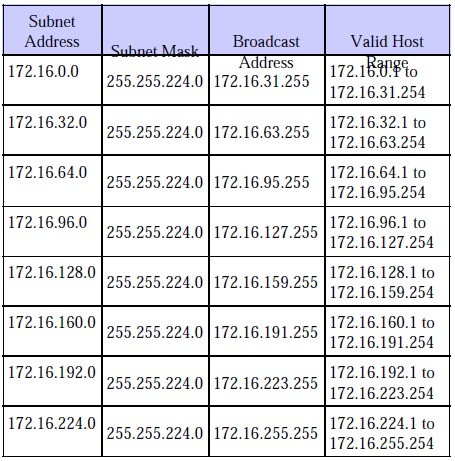

Below is given all possible combination of Class B subnetting − Class C SubnetsĬlass C IP addresses are normally assigned to a very small size network because it can only have 254 hosts in a network. Class B IP Addresses can be subnetted the same way as Class A addresses, by borrowing bits from Host bits. Class B Subnetsīy default, using Classful Networking, 14 bits are used as Network bits providing (2 14) 16384 Networks and (2 16-2) 65534 Hosts. Because these two IP addresses cannot be assigned to hosts, sub-netting cannot be implemented by using more than 30 bits as Network Bits, which provides less than two hosts per subnet. In case of subnetting too, the very first and last IP address of every subnet is used for Subnet Number and Subnet Broadcast IP address respectively. Given below is a list of all possible combination of Class A subnets −

The Subnet mask is changed accordingly to reflect subnetting. To make more subnet in Class A, bits from Host part are borrowed and the subnet mask is changed accordingly.įor example, if one MSB (Most Significant Bit) is borrowed from host bits of second octet and added to Network address, it creates two Subnets (2 1=2) with (2 23-2) 8388606 Hosts per Subnet. In Class A, only the first octet is used as Network identifier and rest of three octets are used to be assigned to Hosts (i.e. By using subnetting, one single Class A IP address can be used to have smaller sub-networks which provides better network management capabilities. Classful IP addressing does not provide any flexibility of having less number of Hosts per Network or more Networks per IP Class.ĬIDR or Classless Inter Domain Routing provides the flexibility of borrowing bits of Host part of the IP address and using them as Network in Network, called Subnet. For more information, see the tnrhdb(4) man page.Each IP class is equipped with its own default subnet mask which bounds that IP class to have prefixed number of Networks and prefixed number of Hosts per network. They should also assess whether to use any wildcard addresses. Sites that need to strictly control remote access should remove the 0.0.0.0 entry. If a computer's IP address cannot be matched to an entry, communication with that computer is not permitted.Ī default 0.0.0.0 entry matches all computers that are not otherwise matched by other entries.
IP SUBNET MASK TABLE SOFTWARE
The trusted network software looks first for an entry that specifically assigns the host to a template, and if it does not find a specific entry, the software looks for the subnetwork entry that best matches the hosts's IP address (a subnetwork with the longest prefix length to which that address IPv6 network addresses can have a prefix length between 1 and 128. IPv4 network addressesĬan have a prefix length between 1 and 32. With variable-length subnetting, the prefix length does not have to be a multiple of 8. Table 7-2 Wildcard Address, Netmask, and Prefix Length

The prefix length determines the size of the subnetĪnd is the number of 1 bits in the netmask. The 255 address is always assigned to a broadcast address, and the 0 address is always assigned to a network address. In this way, the subnet mask separates the IP address into the network and host addresses. A optional Prefix Length can be specified in the form of an integer. A subnet mask is a 32-bit number created by setting host bits to all 0s and setting network bits to all 1s. The netmask determines the prefix that has to be common to all the addresses belonging to a subnetwork.įor example, the IP address 192.168.123.0 is a wildcard with a netmask = 255.255.255.0. A subnetwork is defined by its IP address and its netmask. A wildcard IP address is the IP address of a subnetwork.


 0 kommentar(er)
0 kommentar(er)
